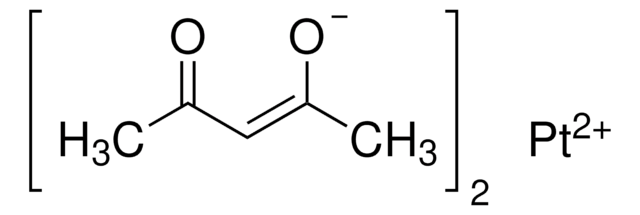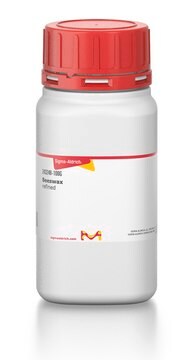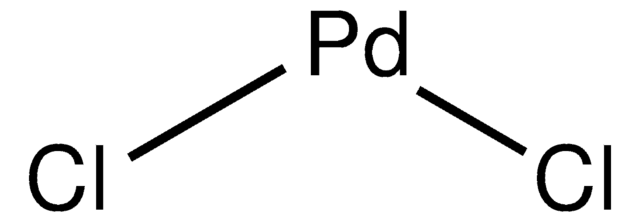Kluczowe dokumenty
262587
Chloroplatinic acid solution
8 wt. % in H2O
Synonim(y):
Hexachloroplatinic acid solution, Hydrogen hexachloroplatinate(IV) solution, Platinic chloride solution, Platinum(IV) chloride solution
About This Item
Polecane produkty
Formularz
liquid
Poziom jakości
przydatność reakcji
core: platinum
reagent type: catalyst
stężenie
8 wt. % in H2O
gęstość
1.05 g/mL at 25 °C
ciąg SMILES
Cl.Cl.Cl[Pt](Cl)(Cl)Cl
InChI
1S/6ClH.Pt/h6*1H;/q;;;;;;+4/p-4
Klucz InChI
GBFHNZZOZWQQPA-UHFFFAOYSA-J
Szukasz podobnych produktów? Odwiedź Przewodnik dotyczący porównywania produktów
Opis ogólny
Chloroplatinic acid solution catalyses the hydrosilylation reaction of 1-Hexyne to form l,6-Bis(trichlorosilyl)hexane.
Zastosowanie
- Platinum precursor in the synthesis of platinum nanoparticles using hydrazine as a reducing agent.
- An electrolyte in the preparation of various carbon-supported platinum nanomaterials with H2SO4 by electrodeposition method in the presence or absence of organic additives.
- An anionic precursor in the preparation of Pt/SBA_BEA catalyst for the hydro isomerization of n-hexadecane.
- A Pt precursor in the preparation of PVP-protected Pt-nanoparticles by seed-mediated growth method.
Hasło ostrzegawcze
Danger
Zwroty wskazujące rodzaj zagrożenia
Zwroty wskazujące środki ostrożności
Klasyfikacja zagrożeń
Acute Tox. 3 Oral - Aquatic Chronic 2 - Eye Dam. 1 - Met. Corr. 1 - Resp. Sens. 1 - Skin Corr. 1B - Skin Sens. 1 - STOT RE 2
Organy docelowe
Kidney
Kod klasy składowania
6.1B - Non-combustible acute toxic Cat. 1 and 2 / very toxic hazardous materials
Klasa zagrożenia wodnego (WGK)
WGK 3
Temperatura zapłonu (°F)
Not applicable
Temperatura zapłonu (°C)
Not applicable
Środki ochrony indywidualnej
Faceshields, Gloves, Goggles, type ABEK (EN14387) respirator filter
Wybierz jedną z najnowszych wersji:
Masz już ten produkt?
Dokumenty związane z niedawno zakupionymi produktami zostały zamieszczone w Bibliotece dokumentów.
Klienci oglądali również te produkty
Produkty
Noble-Metal Nanostructures with Controlled Morphologies
Powiązane treści
Generic QA Testing Page
Nasz zespół naukowców ma doświadczenie we wszystkich obszarach badań, w tym w naukach przyrodniczych, materiałoznawstwie, syntezie chemicznej, chromatografii, analityce i wielu innych dziedzinach.
Skontaktuj się z zespołem ds. pomocy technicznej










